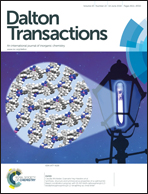The interaction of carboxylic acids with aluminium oxides: journeying from a basic understanding of alumina nanoparticles to water treatment for industrial and humanitarian applications
Abstract
Carboxylic acids are found to react with aluminium oxides via a topotactic reaction such that the carboxylate acts as a bridging ligand. This reaction allows for carboxylate-functionalized alumina nanoparticles to be prepared directly from boehmite (AlOOH). Understanding the structural relationship between molecular and surface species allows for the rationalization/prediction of suitable alternative ligands as well as alternative oxide surfaces. The identity of the carboxylate substituent controls the pH stability of a nanoparticle as well as the porosity and processability of ceramics prepared by thermolysis. Through the choice of functional groups on the carboxylic acid the properties of the alumina surface or alumina nanoparticle can be tailored. For example, the solubility/miscibility of nanoparticles can be tuned to the solvent/matrix, and the wettability to be varied from hydrophobic to super hydrophilic. The choice Zwitter ionic substituents on alumina micro-/ultra-filtration membranes are found to enhance the flux and limit fouling while allowing for the facile separation of organic compounds from water. Examples are presented of purification of frac and flow-back water from oil well production as well as providing drinking water from contaminated sources in underdeveloped regions.


 Please wait while we load your content...
Please wait while we load your content...